Fisher Body Number Plate - 1968
[ Preface ] | [ 1964 ] | [ 1965 ] | [ 1966 ] | [ 1967 ] | [ 1968 ] | [ 1969 ] | [ 1970 ] | [ 1971 ] | [ 1972 ]
[ Atlanta ] | [ Baltimore ] | [ Framingham ] | [ Fremont ] | [ Kansas City ] | [ Oshawa ]
Introduction: For quite some time I’ve had an intense interest in Fisher Body Number plates, a.k.a. trim tag, cowl tag, firewall tag, etc. for 1964 through 1972 Chevelles - hereafter referred to as ‘trim tag’ since that seems to be most common moniker for these little jewels. Their diversity, not only between the different years but between the different plants in a given year, has always fascinated me. This page deals only with 1968 Chevelle trim tags.
The fifth model year of the Chevelle, 1968, saw its final assembly production occur at 5 plants in the U.S. - Atlanta, Georgia - Baltimore, Maryland - Framingham, Massachusetts - Fremont, California - and Kansas City, Missouri - plus Oshawa, Ontario in Canada.
I’ll not attempt to decode what each trim code, paint code, and where applicable, group option codes in this series represent. Click on any year's link in the navigation menu at the top of the page and choose the appropriate link on that year's home page where you’ll find links for detailed information for interior, paint, and group option codes.
There is ongoing research concerning Buick, Olds, and Pontiac (BOP) apparent replacement interiors found on the trim tag of 3 (so far) 1968 plants and the date ranges of those interiors. To date only Baltimore, Kansas City, and Fremont trim tags have been found with alternate interiors from the BOP divisions. See this 1968 interior page for a more in-depth review of this.
All research to date indicates that each Fisher Body plant assigned body numbers in sequential order based on the particular Fisher Body style number. This means that a 300 Deluxe 2-door coupe built immediately after a Malibu convertible would not have sequential body numbers, or even close, since they are different styles. Depending on production numbers of a particular body style number throughout the model year, the above 2-door sedan and Malibu convertible would be vastly different on a given day of assembly but the next 2-door sedan or Malibu convertible would have a sequential body number for that particular style. However, body numbers did not run sequentially from 000001 through some final production.
The Fisher Body unit number has nothing to do with the vehicle identification number (VIN) assigned by GM at final assembly and if any were to match, it’d be a coincidence.
Fisher Body Number plates changes the verbiage embossed on blank tags for 1969.
Fremont, from 1964 through 1967, was the only U.S. final assembly plant to use a style number for L6 engined Chevelles with an odd 3rd digit in the style designation, all other U.S. plants used an even third digit in the style designation for both L6 and V8 Chevelles. Whether this practice continued into the 1968 model year is not known as, to date, no 1968 Fremont trim tags or any other U.S. assembly plant have been submitted with an odd third digit although Oshawa, Ontario continued to do so.
With that, let's begin 1968.
The 1968 Fisher Body Number plate for Atlanta, like Framingham, contained only basic information and no frills.


The first information line has the body assembly date consisting of the month as a 2-digit number and a single letter (A…E) designating the week. When the month is a single digit month (January through September) the month number is padded with a leading zero (0) such as 01, 02, 03, etc. This body date is embossed below the GENERAL MOTORS CORPORATION stamping. In the examples 01B is the 1st month (January) and “B” represents the 2nd week and 05A is the 5th month (May) and "A" represents the 1st week. There is also a hand stamped number (13 and 22 on these examples) that is believed to be a final inspector’s stamp. This 1- or 2-character hand stamped number has been found in various locations on the trim tag so it won’t always be in the same location as the example.
The second information line contains the abbreviation ST (for Style) followed by the model year (68), a hyphen, and the Fisher Body style number. Next is the designation for the plant location, ATL for Atlanta, and the Fisher Body unit number followed by BODY. It should be noted that the Fisher Body style number (13837 for an SS396 sport coupe in the example) has nothing to do with the GM VIN series/model designation. That means the 13837 does not indicate a V8 engine just because the third digit is an even number. Fisher Body did not care if the car was to receive a V8 or L6 engine. Being this example is an SS396 and no L6 SS396 was built, this would naturally be a V8 Chevelle. Generally, the Fisher Body unit number, 07042 and 10074 in these cases, was sequential for the particular Style number.
The third information line contains the abbreviation TR (for Trim) followed by a 3-digit number indicating the seat type (bucket or bench), color and material. Next is a 2-character sequence indicating the exterior paint color with the lower body color represented by the first letter and the upper body color represented by the second letter, and finally the word PAINT. When the second character is a number, it indicates a vinyl or convertible top color. Both examples have the number "2" (G2 and P2) indicating a black vinyl top.
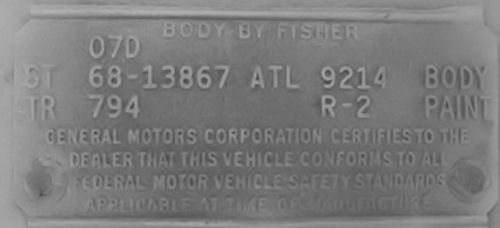
This very late model year tag has a dash between the lower and upper
body colors. Whether this is a reproduction tag or just an anomaly
isn't certain.
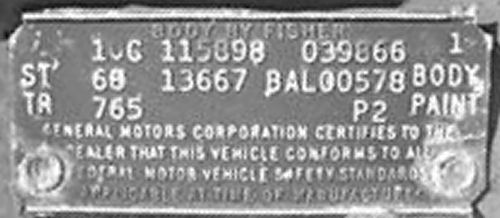
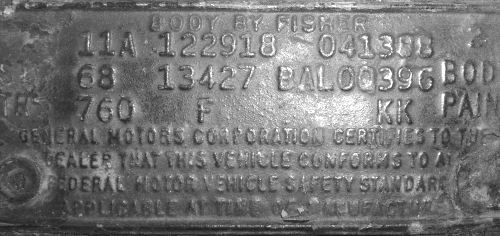

The first information line has the body assembly date consisting of the month as a 2-digit number and a single letter (A…E) designating the week. When the month is a single digit month (January through September) the month number is padded with a leading zero (0) such as 01, 02, 03, etc.
Next are 2 groups of 6-digit numbers that are data processing numbers used during assembly. To date no 1968 Baltimore paperwork such as Body or Chassis Broadcast Copy sheets have surfaced to see just how, and if any, of these numbers correspond to factory paperwork. The Fremont plant also shows a similar 2 pair of 6-digit number groups and it's known these numbers from Fremont are found on their build sheets but Baltimore isn't known for the same format of paperwork in 1968; it would be speculation to say these numbers on Baltimore tags are the same references as on the Fremont tags.
Lastly, the first line contains a single number, either 1- or 2-digit. It’s believed this number is for the body jig, or gate, the body was assembled on and used for quality control.
The second information line contains the abbreviation ST (for Style), followed by the model year (68) and style number. Next is the designation for the plant location, BAL for Baltimore, and the Fisher Body unit number followed by BODY. It should be noted that the Fisher Body style number has nothing to do with the GM VIN series/model designation. Fisher Body at Baltimore did not care if the car was to receive a V8 or L6 engine.
The third information line contains the abbreviation TR (for Trim) followed by a 3-digit number indicating the seat type and color. Beginning sometime around 03D and continuing until at least 06B almost all black bench and bucket seats in Malibu and SS396 series Chevelles used Buick, Oldsmobile, or Pontiac (BOP) interiors and this was shown with a hyphen and a corresponding BOP code number such as the -980 in the last example and only black interiors were affected. See this 1968 interior page for a more in-depth review of this. Even after the BOP interiors were no longer being substituted, the 3-digit trim code number continued to have a hyphen after the code number.
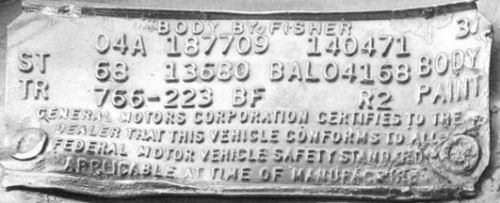
A 1- or 2-character code is found on several Fisher Body styles following the interior trim code. Found so far have been the single letter "B" on Malibu and SS396 sport coupes, the single letter "F" on 300 Deluxe 2-door coupes, and the two letters "BF" found on Malibu and SS396 El Caminos; all convertibles to date have not had any letters in this location. Whether station wagons or 300 Deluxe sport coupes do or not isn't known as I have no examples of any station wagons or 300 Deluxe sport coupes from Baltimore.
Next is a 2-character sequence indicating the exterior paint color with the lower body color represented by the first letter and the upper body color represented by the second letter, and finally the word PAINT. If the car has a vinyl or convertible top, the second character in the paint code is a number and designates the top's color as shown in two of the examples where the "2" represents a black convertible top and vinyl top respectively.
The 1968 Framingham Fisher Body Number plate, like Atlanta, contained only basic information and no frills.
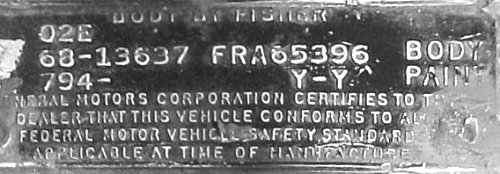
The first information line has the body assembly date consisting of the month as a 2-digit number and a single letter (A…E) designating the week. When the month is a single digit month (January through September) the month number is padded with a leading zero (0) such as 01, 02, 03, etc. This body date is embossed below the GENERAL MOTORS CORPORATION stamping. In the example, 02E is the 2nd month (February) and “E” represents the 5th week.
The second information line contains the abbreviation ST (for Style) followed by the model year (68), a hyphen, and the Fisher Body style number. Next is the designation for the plant location, FRA for Framingham, and the Fisher Body unit number followed by BODY. It should be noted that the Fisher Body style number (13637 for an Malibu sport coupe in the example) has nothing to do with the GM VIN series/model designation. That means the 13637 does not indicate a V8 engine just because the third digit is an even number. Fisher Body did not care if the car was to receive a V8 or L6 engine. In the case of an SS396, and no L6 SS396 was built, this would naturally be a V8 Chevelle but in the case of the other non-SS396 trim tags, one cannot know from the style number if the car was built with an L6 or V8 engine. Several instances of an L6 VIN with an odd 3rd digit have been found where the Fisher Body style number shows an even 3rd digit. Generally, the Fisher Body unit number, 65396 in this case, was sequential for the particular Style number but it's fairly certain that each style number did not start with 00001; it's just not known with what number a given style did begin with.
The third information line contains the abbreviation TR (for Trim) followed by a 3-digit number followed by a hyphen. Next is a 2-character sequence indicating the exterior paint color with the lower body color represented by the first letter, a hyphen, and the upper body color represented by the second letter, and finally the word PAINT. When the second character is a number, it indicates a vinyl or convertible top color.

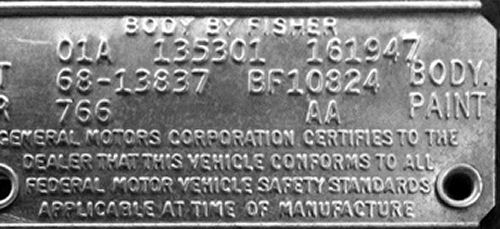
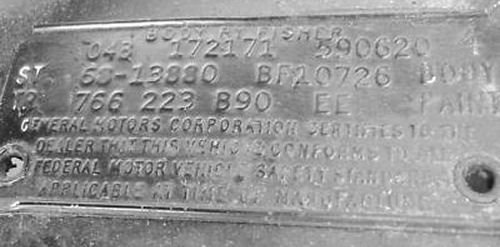
The first information line has the body assembly date consisting of the month as a 2-digit number and a single letter (A…E) designating the week. This body date is embossed below the BODY BY FISHER stamping. In the examples 12B is the 12th month (December) and “B” represents the 2nd week, 01A is the 1st month (January) and "A" represents the 1st week, 04B represents the 4th month (April) and “B” represents the 2nd week.
Next are 2 groups of 6-digit numbers that are data processing numbers used during assembly. These numbers from Fremont are found on their build sheets.
The second information line contains the abbreviation ST (for Style) followed by the model year (68), a hyphen, and the Fisher Body style number. Next is the designation for the plant location, BF for Fremont, the Fisher Body unit number and the word BODY. It appears as though the body numbers continue to be sequential for the particular style number. Fremont matched the Fisher Body Style number to the GM series/model designation in the VIN, meaning Fremont would use a style number such as 13127 or 13537 to designate an L6 engine in the car where other plants would use a style number of 13227 or 13637 regardless of engine.

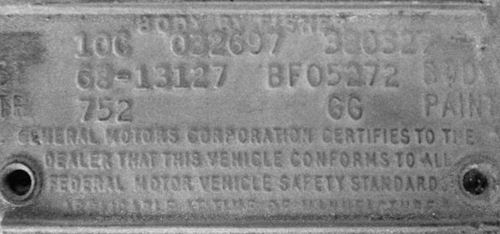
The third information line contains the abbreviation TR (for Trim) followed by a 3-digit number indicating the seat type and color. Beginning sometime around 03E and continuing until at least 05D almost all black bench and bucket seats in Malibu and SS396 series Chevelles used Buick, Oldsmobile, or Pontiac (BOP) interiors and this was shown with a corresponding BOP code number such as the 223 in the last example and only black interiors were affected. See this 1968 interior page for a more in-depth review of this.
On El Camino trim tags the RPO code B90 (for Door Window Frame Molding) is embossed on Malibu and SS396 series El Caminos.
Next is a 2-character paint code and the word PAINT. If the second character is a number, such as "2" in the first example, this indicates a black convertible or vinyl top.
The 1968 Kansas City Fisher Body Number plate was fairly straightforward with 3 lines of information and consistent throughout the model year.
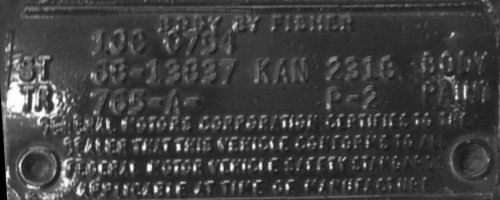

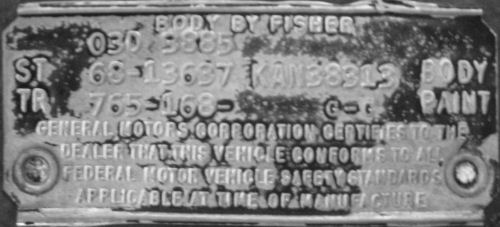
The first information line has the body assembly date consisting of the month as a 2-digit number and a single letter (A…E) designating the week. When the month is a single digit month (January through September) the month number is padded with a leading zero (0) such as 01, 02, 03, etc. This body date is embossed below the BODY BY FISHER stamping. In the examples, 10C is the 10th month (October) and “C” represents the 3rd week and 03D is the 3rd month (March) and "D" represents the 4th week. The 4-character number is obviously some internal plant tracking code but to date it has not turned up on any paperwork so it's significance is unknown.
The second information line contains the abbreviation ST (for Style) followed by the model year (68), a hyphen and the Fisher Body style number. Next is the designation for the plant location, KAN for Kansas City, and the Fisher Body unit number followed by BODY. It should be noted that the Fisher Body style number (13837 for an SS396 sport coupe, 13227 for a 300 2-door coupe, or 13637 for a Malibu sport coupe in the examples) has nothing to do with the GM VIN series/model designation. That means the 13637 does not indicate a V8 engine just because the third digit is an even number. Fisher Body did not care if the car was to receive a V8 or L6 engine. In this case of style of the 13227, at least one is known to be an L6 car because the VIN begins with 13127. Generally, the Fisher Body unit numbers, 2318, 244, and 38313 in these examples, was sequential for the particular Style number.
The third information line contains the abbreviation TR (for Trim) followed by a 3-digit number, a hyphen, a letter indicating the seat type and color, followed by another hyphen. The letter "A" indicates a bench seat, the letter "B" indicates a bucket seat, and the letter "S" indicates head rests.
Beginning sometime around 03D and continuing until at least 06A almost all black bench and bucket seats in 300 Deluxe, Malibu and SS396 series Chevelles used Buick, Oldsmobile, or Pontiac (BOP) interiors and this was shown with a corresponding BOP code number such as the 168 in the last example and only black interiors were affected. See this 1968 interior page for a more in-depth review of this.
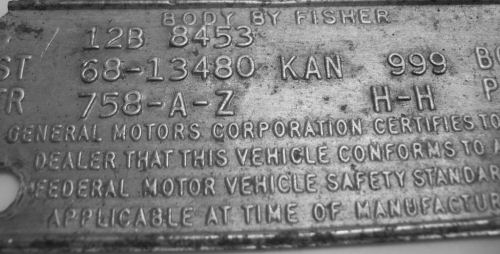
On at least all 13227, 13427, and 13480 series trim tags to date, a 1-character ("Z") or 2-character ("XZ") code follows the trim number. The apparently has something to do with some sort exterior trim moldings but just what isn't known at this time.
Next is a 2-character sequence indicating the exterior paint color with the lower body color represented by the first letter, a hyphen, and the upper body color represented by the second letter, and finally the word PAINT. When the second character is a number, it indicates a vinyl or convertible top color. One oddity is the paint letter "G" for Ash Gold was a much smaller letter. The reasoning for this is unclear but this began in the 1967 model year at Kansas City as well sometime between 10D and 11D.
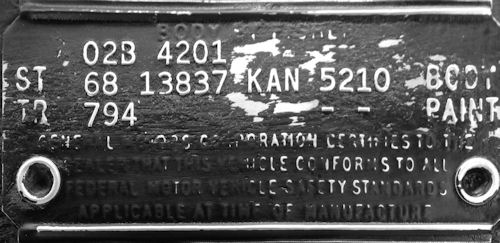

If there are one or two hyphens in the paint code positions or the letter "O" it indicates the car was ordered with the special paint option as in the examples above. See the paint code page for more information on special order paint.
The Oshawa, Ontario plant Style number does indicate whether the
car was to have an L6 or V8 engine. The 1968 model year saw the introduction
of a completely new style of trim tag. Not only did the physical size
change from the previous 1-3/4" x 4" to 2-3/16" x 3-1/2"
but now had MADE IN CANADA embossed on the top portion of the tag but
GENERAL MOTORS CERTIFIES TO THE DEALER
THAT THIS VEHICLE CONFORMS TO ALL U.S.
GENERAL MOTORS VEHICLE SAFETY STANDARDS
APPLICABLE AT TIME OF MANUFACTURE
and BODY BY FISHER across the bottom.

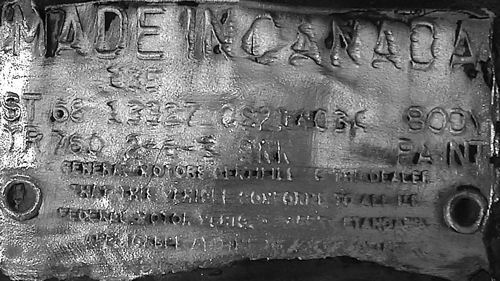
While 1968 Oshawa trim tags came more in line with their U.S. counterparts, there were still some differences.
The first information line has various RPO codes that are applicable to the car. Of note in the first example is RPO code C08 for a vinyl top and T-27 for a black vinyl top but note the paint code on the third information line still indicates FF for lower and upper body color.
The second information line has the abbreviation ST for style number followed by the particular body style designation, 13837 and 13327 on the examples.
Next is the plant designation OS followed by a 6-digit body number and the word BODY. It's believed this body number is sequential regardless of the style. It is not known at this time what the starting number might have been.
The third information line begins with the abbreviation TR for trim followed by a 3-digit number for the trim code.
Next is the assembly date; 2 is for the second shift (of 2 at the plant) in these examples, a hyphen, followed by a number for the month, a hyphen, and a number for the day of the month. Since the trim tag went on the car at the start of the assembly cycle and it might take anywhere from 3 to 5 days for a car to complete the assembly process, it's assumed this date is when the car was scheduled to begin assembly, not when it finally rolled off the assembly line.

Next is a 2-character code for the paint color. As noted before, both characters represent be basic car's color and does not indicate a vinyl top color or convertible top color or even the presence of a vinyl top or even a convertible as indicated by this Malibu convertible trim tag with paint code of QQ.

 Home
Home Decode
Decode Tech
Tech Tools
Tools Dale's Coins/CDs
Dale's Coins/CDs Contact
Contact Chevelle
of the Month
Chevelle
of the Month Things
For Sale
Things
For Sale Custom
Stickers
Custom
Stickers